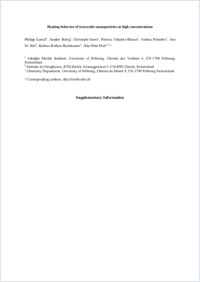Heating behavior of magnetic iron oxide nanoparticles at clinically relevant concentration
- Lemal, Philipp Adolphe Merkle Institute, University of Fribourg, Switzerland
- Balog, Sandor Adolphe Merkle Institute, University of Fribourg, Switzerland
- Geers, Christoph Adolphe Merkle Institute, University of Fribourg, Switzerland
- Taladriz-Blanco, Patricia Adolphe Merkle Institute, University of Fribourg, Switzerland
- Palumbo, Andrea Adolphe Merkle Institute, University of Fribourg, Switzerland
- M.Hirt, Ann Institute for Geophysics, ETH Zurich, Switzerland
- Rothen-Rutishauser, Barbara Adolphe Merkle Institute, University of Fribourg, Switzerland
- Petri-Fink, Alke Adolphe Merkle Institute, University of Fribourg, Switzerland - Chemistry Department, University of Fribourg, Switzerland
-
15.03.2019
Published in:
- Journal of Magnetism and Magnetic Materials. - 2019, vol. 474, p. 637–642
English
Magnetic hyperthermia for cancer treatment has gained significant attention in recent years, due to its biocompatibility of applied nanoparticles and the possibility for spatially localized heating in deep tissues. Clinical treatments use nanoparticle concentrations of 112 mg Fe/mL, while the concentrations experimental studies have addressed are considerably smaller, usually between 0.1 and 30 mg/mL. Therefore, it is not clear whether such experiments correspond to the magnetic properties found in clinical applications. In this regard, we studied the thermal behavior of superparamagnetic iron oxide nanoparticles (SPION) with the most common particle shapes used in the field, including spherical (core diameters 11 and 19 nm), cubic (15 nm) and ellipsoidal (23 nm with an aspect ratio of 1.45), at concentrations ranging from 5 to 80 mg Fe/mL. Their shape, size, crystallinity, magnetic, and thermal behavior were characterized via transmission electron microscopy, dynamic light scattering, Taylor dispersion analysis, X-ray diffraction, alternating gradient magnetometry, and lock-in thermography. Spherical and cubic nanoparticles displayed linear heating slopes, independent from size, shape and concentration, resulting in unchanged specific absorption rates (SAR). Ellipsoids showed the same behavior until 50 mg/mL, above which a decreasing heating slope trend was found, without evidence as to what causes this behavior. However, the presented results highlight the importance of colloidally stable SPIONs in magnetic hyperthermia to obtain maximum heating power by minimum particle dosage.
- Faculty
- Faculté des sciences et de médecine
- Department
- Département de Chimie, AMI - Physique de la matière molle, AMI - Bio-Nanomatériaux
- Language
-
- English
- Classification
- Chemistry
- License
- License undefined
- Identifiers
-
- RERO DOC 324310
- DOI 10.1016/j.jmmm.2018.10.009
- Persistent URL
- https://folia.unifr.ch/unifr/documents/307601
Other files
Statistics
Document views: 92
File downloads:
- fin_hbm.pdf: 275
- fin_hbm_sm.pdf: 120

